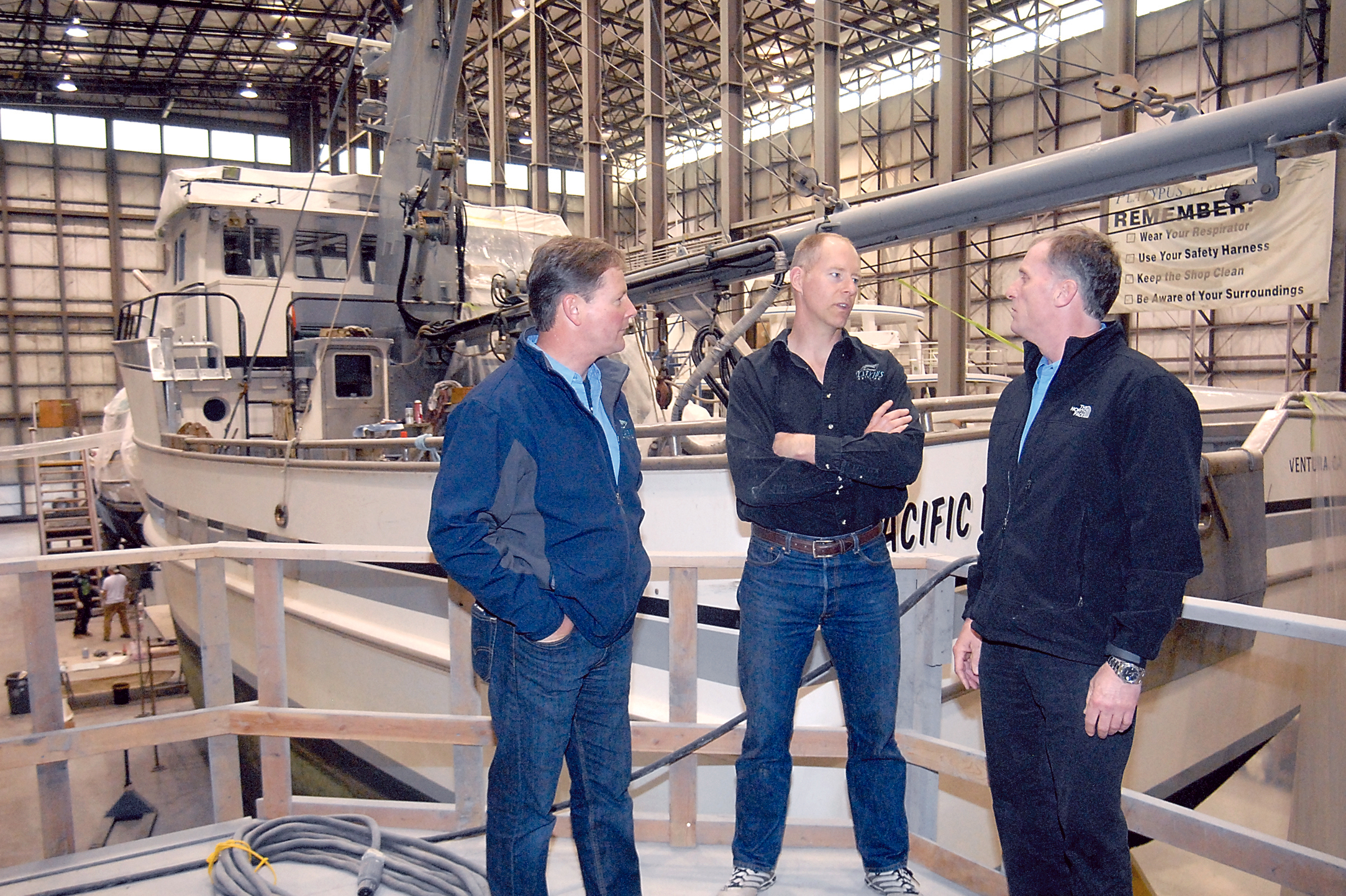PORT ANGELES — Platypus Marine Inc. wants to employ 75 more people in new and refurbished buildings on 5 acres of waterfront property adjacent to its headquarters at 102 N. Cedar St.
The hitch: Platypus wants to buy the site, which it values at about $700,000, but the Port of Port Angeles wants to give the firm a long-term lease.
If port commissioners approve the sale of the site on Port Angeles Harbor, it would copy the deal struck with Westport Shipyard — Platypus’ next-door neighbor — where the shipyard launches its 164-foot luxury yachts. Westport opened its 100,000-square-foot building in 2003.
Rather than risk losing the project, port Commissioners Jim Hallett and Colleen McAleer said Thursday they would agree to sell the site — especially with strings.
Commissioner John Calhoun, however, expressed reservations about relinquishing the public trust on harborfront property.
Platypus, which has operated in Port Angeles for 15 years, hopes to hire 75 new employees over five years with paychecks averaging $48,500, Marty Marchant, the firm’s marketing director, told port commissioners during Thursday’s special meeting.
The average wage would be about $12,000 more per year than Clallam County’s prevailing wage, he said.
The firm would hire six people the first year, 35 by the third year and 75 when the expansion topped off.
Platypus now employs 70 people building and repairing recreational craft, commercial fishing boats and Navy and Coast Guard vessels.
It would spend $5 million over five years for a new two-story production shop, wash-down area and Travelift shed.
The expansion, Marchant said, would double Platypus’ production capacity.
It also would include dry-dock spaces with utilities and pave a boat yard that currently is dusty in dry weather and muddy when wet, he said.
Judson Linnabary, Platypus president, said the tract is worth “$700,000 and change,” according to a market appraisal.
Clallam County Assessor Pam Rushton said she couldn’t confirm that figure because it is owned by the port but added that she’d like to see it sold into private hands.
“I’d like to see things go back onto the tax rolls,” Rushton said. “It shares the tax burden.”
Linnabary expressed frustration with port officials.
Platypus approached the port more than a year ago with its proposal to buy the site, Linnabary said, but Hallett said Thursday’s meeting was the first where he had seen “specifics.”
Calhoun said it had been months since the port received Platypus’ proposal, but “we kept saying we needed to talk about implications of selling industrial-zoned property on the waterfront.
“We weren’t ready to take a vote on that until we had those discussions, so we asked them to make a presentation.
“I think it was a valuable discussion. [Linnabary] just doesn’t understand why we just don’t sell it to him.”
The Platypus expansion would spin off related marine-trades jobs such as sandblasters who clean boat hulls, marine mechanics and marine electronics experts, Marchant said, and add to the Clallam County economy the spending of boat crews lodging in Port Angeles.
The economic impact would total $3.5 million in new income, with another $1.2 million from spun-off jobs, Marchant said.
The expansion also would provide more than $500,000 in new tax revenues, he added.
He called the project “a much-needed stimulus into the local economy.”
But commissioners seemed cool to the notion of selling waterfront public property it had acquired over nearly a century from private shipping and timber companies.
“Would less than an outright sale be sufficient?” asked Hallett, who suggested that Platypus work with port Executive Director Ken O’Hollaren on a 50-year lease with a 30-year renewal option.
Platypus at least should consider a guarantee to sell the site back to the port if the company encounters financial troubles or should incorporate a first right of refusal into the sale, he said.
Linnabary said only outright ownership could ensure company control of the site.
A lease would bind Platypus to changes in port policy and make the project look riskier to backers and customers, he said.
“Our clients want certainty that we’re not going anywhere,” he said.
“They want to know we’re going to be around in 10 years.”
Private ownership also would exempt Platypus from certain regulations, Linnabary said.
“You can control the costs. When there’s a government agency involved, it can be difficult to get things done.”
Marchant cited the Westport sale — which included a buy-back provision — which drew enthusiastic public support when it was presented a dozen years ago.
“It lays down a perfect business model; it lays down success,” Linnabary said.
But Calhoun called that deal “very controversial” and “a judgment call on the part of the commissioners.
“It was an issue of whether we were going to have a public port here or not,” he said.
“If you were to talk to those commissioners who are still alive, I think they still are unsure if they really made the right decision.”
Thursday’s discussion ended with Linnabary and Marchant agreeing to meet with O’Hollaren over the next month.
“I don’t believe we can’t design a lease that would contain long-term conditions” to protect the public trust of the land,” Calhoun said.
As the land’s lessor, he told Linnabary, “we also can help in the financing, the processing, the stormwater development. We’d like to be partners with you.”
Although they, too, would prefer to lease the site, McAleer and Hallett said they would agree to a sale.
Not so Calhoun.
“If it’s just sell or no,” he told Marchant and Linnabary, “then I’m not sure I’m going to be able to support the sale of the property.”
________
Reporter James Casey can be reached at 360-452-2345, ext. 5074, or at jcasey@peninsuladailynews.com.
